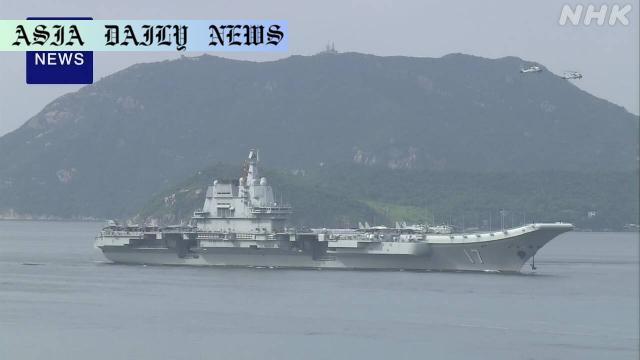Shandong: China dispatches its first domestically-built aircraft carrier to Hong Kong for the first time since 1997.
China’s first domestically-built aircraft carrier, Shandong, visited Hong Kong for the first time.
This visit coincides with the 28th anniversary of Hong Kong’s return to China.
Shandong’s arrival aims to boost patriotism and emphasize Chinese sovereignty in Hong Kong.
The carrier will open to the public for two days, with 2,000 expected visitors.

China’s Maritime Power: Shandong Marks A Historic Hong Kong Visit
The Shandong, China’s first domestically-built aircraft carrier, has made a significant journey to Hong Kong, symbolizing a powerful message of national pride and sovereignty. This marks the first visit of the Shandong to Hong Kong since the territory came under Chinese rule in 1997, following its handover from Britain. The timing of this momentous event coincides with the 28th anniversary of Hong Kong’s return to China on July 1, further magnifying the symbolic significance of this historic voyage.
Showcasing National Power and Modern Technology
The Shandong, measuring an impressive 300 meters, serves as a testament to China’s advancements in naval defense and modern technology. Having helicopters and fighter jets stationed on its expansive deck demonstrates its operational capability and readiness, positioning it as a strategic symbol of China’s growing global influence. Anchored just off Hong Kong’s coast, the iconic warship has drawn significant attention and is expected to remain in the territory until Monday. Public visits are set for two days, starting on July 5, with an anticipated crowd of 2,000 individuals keen to witness firsthand a display of China’s maritime achievement.
Strengthening Patriotism in Hong Kong
Beyond its naval prowess, the Shandong’s visit carries substantial political and societal undertones. By parading its first indigenous aircraft carrier in Hong Kong, Beijing is underscoring its firm stance on the territory and promoting patriotic unity among its citizens. The occasion also adds a layer of preparation for the forthcoming 80th-anniversary celebration of China’s World War II victory over Japan, which will see major ceremonies both in Hong Kong and mainland China. Leveraging powerful military imagery, China aims to assert the integration of Hong Kong with the mainland while reigniting patriotic sentiments in a city marked by years of political unrest.
Geopolitical Implications of Shandong’s Deployment
The Shandong’s presence also holds broader consequences on the international stage. Last month, both Shandong and another Chinese aircraft carrier were spotted sailing in the Pacific, showcasing China’s expanding blue-water navy prowess. This movement prompted an alert in neighboring nations, including Japan. During their maneuvers, a fighter jet from the Shandong flew dangerously close to a Japanese reconnaissance plane, leading to diplomatic tension between the two nations. The Shandong’s voyage to Hong Kong can therefore be viewed as part of a strategic effort to project dominance and assure its readiness in disputed waters across the Asia-Pacific region.
What Lies Ahead for Hong Kong and China’s Maritime Future
The Shandong’s historic visit to Hong Kong symbolizes far more than military might; it signifies China’s aspiration to solidify its territorial claim and foster a closer bond between Hong Kong and the mainland. As the carrier opens its doors for public observation, it will undoubtedly serve as a powerful reminder of China’s modern naval achievements and its commitment to uniting its territories. This event not only reflects China’s past achievements but also sets the stage for what lies ahead in its pursuit of global maritime excellence.
Commentary
Shandong’s Visit: An Iconic Symbol of Unity and Strength
The arrival of China’s first domestically-built aircraft carrier, Shandong, in Hong Kong is a significant event that carries deep symbolic meaning. It highlights the capability of China to produce world-class naval vessels and underscores the country’s determination to project its sovereignty over Hong Kong, especially on the 28th anniversary of its handover. This milestone event acts as a powerful display of China’s military modernization, offering a unique moment of reflection on its growing maritime influence.
A Timely Gesture Amid Rising Geopolitical Tensions
The timing of the Shandong’s deployment cannot be overlooked. With increasing naval activities in the Pacific and growing tensions with neighboring countries such as Japan, the presence of Shandong sends a clear signal: China is ready to bolster its presence both regionally and internationally. While its visit to Hong Kong might be intended to spark patriotism, it simultaneously showcases China’s readiness to challenge rivals in contested waters, reaffirming its geopolitical ambitions.
The Role of Public Engagement and Unity
What stands out significantly is China’s decision to make the Shandong accessible to the public. By opening the vessel for tours, it provides an opportunity to ignite patriotic pride among Hong Kong residents. However, given the city’s political complexities, this visit could also polarize opinions further. Nonetheless, it is clear that the Chinese government strategically uses such displays of power to rekindle bonds with the territory, solidifying its narrative of unity and national pride.
Looking Towards a Maritime Future
The Shandong’s historic tour marks another stepping stone toward China’s aspirations of becoming a dominant maritime power. At home, it inspires pride and confidence in the nation’s achievements, while abroad, it signals determination to hold its position on global and regional stages. As China continues to develop its naval capabilities, we can anticipate similar high-profile deployments that blend strategy, politics, and technology to convey a unified message of strength and vision.


